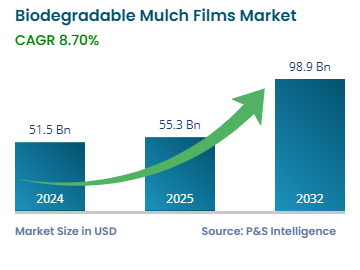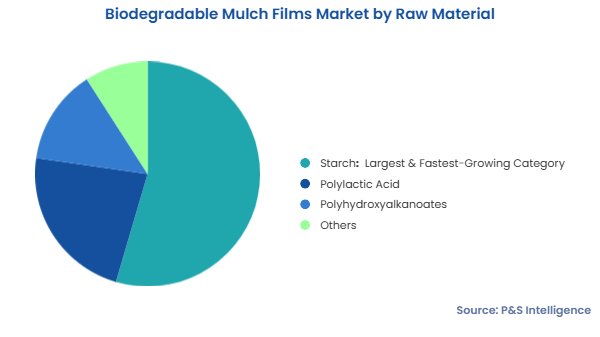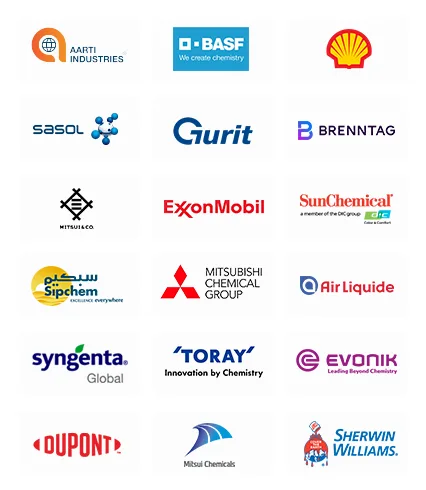Market Statistics
| Study Period | 2019 - 2032 |
| 2024 Market Size | USD 51.5 Billion |
| 2025 Market Size | USD 55.3 Billion |
| 2032 Forecast | USD 98.9 Billion |
| Growth Rate (CAGR) | 8.7% |
| Largest Region | APAC |
| Fastest Growing Region | APAC |
| Nature of the Market | Fragmented |
Report Code: 11388
This Report Provides In-Depth Analysis of the Biodegradable Mulch Films Market Report Prepared by P&S Intelligence, Segmented by Raw Material (Starch, Polylactic Acid, Polyhydroxyalkanoates), Crop Type (Fruit & Vegetables, Grains & Oilseeds, Flowers & Plants), and Geographical Outlook for the Period of 2019 to 2032
| Study Period | 2019 - 2032 |
| 2024 Market Size | USD 51.5 Billion |
| 2025 Market Size | USD 55.3 Billion |
| 2032 Forecast | USD 98.9 Billion |
| Growth Rate (CAGR) | 8.7% |
| Largest Region | APAC |
| Fastest Growing Region | APAC |
| Nature of the Market | Fragmented |


|
Explore the market potential with our data-driven report
The global biodegradable mulch film market was valued at USD 51.5 billion in 2024, and the size is predicted to reach USD 98.9 billion by 2032, advancing at a CAGR of 8.7% during 2025–2032. The industry is driven by the growing awareness regarding the harmful effects of inorganic mulching and supportive government regulations.
Starch is widely used as a raw material for biodegradable mulch films, owing to the unavailability of conventional film-forming resins. Starch-based film is expected to register significant growth, as they are less expensive as compared to other raw materials, and are also abundantly available. Moreover, benefits, such as weed control, maintenance of soil structure, and prevention of crops from soil contamination offered by starch-based biodegradable mulch film are highly appreciated by users. Moreover, farmers have shifted their focus toward the adoption of starch as a raw material, as usage of inorganic mulch film leads to increased environmental concerns.
The rapidly increasing global population offers a major growth opportunity for the industry.
Starch had the largest market share, of 60% in 2024. Starch has been the largest raw material till now, due to its several benefits, such as low cost, compatibility with different soil types, and environmental sustainability. Owing to such benefits, the use of starch-based mulch film is growing among end users across the globe. Starch is employed as a viscosifier, emulsifier, defoaming agent, encapsulant, and sizing agent in a variety of industrial applications. Starches are prized for their ability to impart textural properties as well as providing gelling or film formation.
Starch-based film is expected to register significant growth, as they are less expensive compared to other raw materials, and are also abundantly available.
Moreover, thermoplastic starch (TPS) is environment friendly which can be used as an organic fertilizer. To some extent, the accumulation of plastic materials might contribute to environmental pollution. Although, most old plastics are resistant to microbial attack, the pollution caused by them is primarily aesthetic. As a result, there is growing interest in the creation of biodegradable polymers, produced from renewable natural resources. Many basic and advanced studies, which term starch as an inexpensive and abundant natural polymer are now being done. The research and production of biodegradable TPS is important in reducing total synthetic plastic waste.
PHA is the fastest-growing category because it is insoluble in water and relatively resistant to hydrolytic breakdown with good UV protection. PHA is also appropriate for medical purposes as chloroform and other chlorinated hydrocarbons are soluble in it and it is biocompatible and nontoxic. PHAs are also unique in that, they are both bio-based and biodegradable. "Bio-based" is a fairly broad term that simply signifies a material was derived entirely or partially from an organic (typically plant-based) source. Bio-based plastics are very different from more frequent petroleum-based polymers.

These raw materials are covered:
The fruits & vegetables category dominates the market, and it also has the highest CAGR, of 10%, in the forecast period. The demand for biodegradable mulching for fruit & vegetables is growing, owing to its low life time cost and ban on inorganic mulching materials in many countries. Globally, almost 2,500 square miles of agricultural land is used for mulching of fruits & vegetables. Around 99% of the mulching of fruits & vegetables is conducted by using polyethylene mulch. Polyethylene mulch is spread as a protective layer on top of the soil in crop production, as it offers benefits such as, soil conservation, decreases soil erosion, and maintains soil temperature. The mulching of fruits and vegetables also aids faster crop growth, weed control, better moisture retention, minimized fertilizer leaching, and improved crop quality.
These crop types are covered:
Drive strategic growth with comprehensive market analysis
APAC held the largest revenue share, of 40%, in 2024, and it will grow the fastest, with 11% CAGR, as its growing population drives the demand for crop production. Moreover, the rise in population would lead to reduction of agricultural land, thereby compelling the farmers to produce more in the same agricultural landholding.
The increase in population in countries of the region has given rise to increased requirement for food; thus, farmers have adopted the use of biodegradable mulching technique, owing to the adverse effects of inorganic mulching on the environment. The use of these film also enhances crop yield, thereby making itself the first preference of farmers for mulching in the region. Manufacturers like BASF SE are investing in China due to increased demand from APAC.
Moreover, farmers were forced to produce more on the same land due to expanding population and dwindling agricultural land as a result of industrialization and urbanization.
Moreover, Supportive government regulations for organic mulching across the globe is one of the major factors driving the market. As per the degradation standards to compost (ISO 17088, ASTM D6400), 90% of the carbon, which is organic, is required to be converted CO2, limiting the acceptance of inorganic mulching technique.
Moreover, Europe held the second largest share in the market. In Europe, 95% inorganic mulching includes the use of fossil-based and non-biodegradable materials that are mostly manufactured outside Europe. Benefits offered by biodegradable mulching technique has encouraged farmers to use this technique for crop production. Governments of France and Italy have formulated regulations regarding the use of biodegradable mulch films. Moreover, the European Committee for Standardization (CEN) is also working on developing a European standard regarding the use of these films. Furthermore, European Fertilizers Regulation and European Bioplastics recommend, including biodegradable mulch films as a soil improver for farmers.
Moreover, the market for biodegradable mulch film in LAMEA is relatively new as compared to other regions. Farmers have been widely using inorganic mulching materials for crop production in the region. However, unfavorable effects of these materials on the environment have led to high adoption of mulching technique from biodegradable resources.

The regions and countries analyzed for this report include:
The total size of the market for biodegradable mulch films was USD 51.5 billion in 2024.
APAC has the largest share in the biodegradable mulch film industry in 2024.
The market for biodegradable mulch films is fragmented.
Growing awareness regarding the negatives of inorganic munching is trending in the biodegradable mulch film industry.
Starch is the largest used raw material in the market for biodegradable mulch films.
Want a report tailored exactly to your business need?
Request CustomizationLeading companies across industries trust us to deliver data-driven insights and innovative solutions for their most critical decisions. From data-driven strategies to actionable insights, we empower the decision-makers who shape industries and define the future. From Fortune 500 companies to innovative startups, we are proud to partner with organisations that drive progress in their industries.


Working with P&S Intelligence and their team was an absolute pleasure – their awareness of timelines and commitment to value greatly contributed to our project's success. Eagerly anticipating future collaborations.
McKinsey & Company
IndiaOur insights into the minutest levels of the markets, including the latest trends and competitive landscape, give you all the answers you need to take your business to new heights
We take a cautious approach to protecting your personal and confidential information. Trust is the strongest bond that connects us and our clients, and trust we build by complying with all international and domestic data protection and privacy laws
Customize the Report to Align with Your Business Objectives
Request the Free Sample Pages